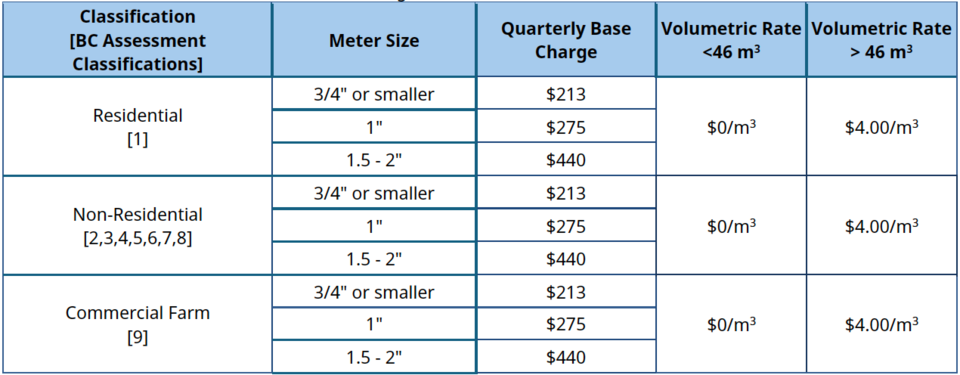As volumetric billing approaches for North and South Pender water systems, the Sunshine Coast Regional District's (SCRD) model for how such billing will work is taking shape.
Though simple in concept, execution is far from straightforward, Elphinstone director Donna McMahon noted at the May 22 committee of the whole.
Mock volumetric billing for the two Pender systems is proceeding this year, with actual billing next year.
Class breakdown

Under the new model, there’s a base rate determined based on property class (residential, non-residential or commercial farm, as per BC Assessment) and meter size (¾ inch or smaller, one inch, and 1.5 to 2 inch). The lowest rate is for the smallest meter size and that is multiplied by 1.3 for the mid-meter size and by 2.1 for the largest meter size. As of the current proposal, there are no changes to the base charge based on property class, only for water meter size, as the life cycle costs are proportionally greater for the larger meter sizes.
Included in that base rate will be a quarterly consumption allowance of 46 cubic metres per connection (or 500 litres per day), intended to encompass essential household activities, such as cooking, bathing and washing laundry.
For mock billing, the base rate for the smallest meter size is set at $212.50 quarterly and usage exceeding 46 cubic metres per quarter will be charged $4 per cubic metre across all classifications (consumption charge).
Actual rates and charges for when volumetric billing starts for real next year are still to be confirmed.
Last year, about 45 per cent of meters in Pender Harbour didn’t exceed the 46 cubic metre threshold in any of the quarters, said a staff report.
The threshold “provides cost certainty for lower volume users, while incentivizing heavier users to reduce consumption,” said Kyle Doyle, manager of asset management. “This allowance can be reviewed and should be reviewed annually and adjusted as residents become more efficient with their water consumption.”
Cost recovery
The rate structure aims to have 80 per cent of the systems’ revenue recovery through base charges and 20 per cent through consumption charges –– something that may change as consumption patterns change to adapt to volumetric billing.
Revenue needs to be able to cover the system’s operations “while striving to be fair and equitable to all users,” said the staff report.
Billable consumption (above that quarterly allowance) is projected to decrease up to 50 per cent from 2024 levels next year as people will have a strong incentive to conserve (money). Should this come to pass, the $4 per cubic metre consumption charge would “recover sufficient revenue for both North and South Pender Harbour Water Services’ 2025 Operating budget,” indicated the staff report.
One challenge will be for customers who share a water meter, who currently each pay flat rates, notes the staff report, as “it is impossible to determine the allocation to the individual users of a shared meter.”
There is also a risk, the report cautioned, that if consumption patterns drastically change, it may mean insufficient revenue is collected for the system. “In winter months as few as 6% of customers use more than 50% of the water. In the summer months nearly 70% of the water is consumed by 25% of the customers.”
Residents who resolve major service line leaks are also given a bill credit proportional to the volume that leaked, which will also affect revenue recovery, said the report.
What about the really low water users?
Directors noted that volumetric billing does not mean that low water users will automatically see their bills decrease.
“If we reduce our water use to zero, we still have to pay for transmission because we have to keep up the system,” said Roberts Creek director Kelly Backs.
McMahon noted that 500 litres is a lot of water and that 33 per cent of users in Pender Harbour use under 100 litres a day and asked why they haven’t looked at benefiting super low-use water users.
Doyle said the rate structure does provide a break for low water users and it will adapt over time. “This is the gradual approach, where we were avoiding a snap decision to a completely new paradigm.”
The rate implementation and evolution will ultimately be the next board’s challenge, noted Sechelt director Alton Toth, referencing that this board’s term ends in October 2026.
Gibsons Mayor Silas White said that the town is the SCRD’s “biggest cheerleader in moving forward with this process.”
White said he still finds water really cheap, given it it is “such a crucial element to our existence,” and “all the infrastructure costs that are involved.”
It will take an estimated 17 staff members to transition the systems to volumetric billing, the report said, and more than 2,800 staff hours. (CAO Tina Perrault noted that this is a “test pilot as we go forward” and these are small, separate systems that don’t have the economies of scale like the regional, including Chapman, water system will have when it moves to volumetric billing. “The lessons learned will inform the regional implementation,” she said.)
When volumetric billing expands to the Chapman system, there’s room to create more granularity in the classifications, said Doyle.
Directors approved the rate structure and mock billing prices, however, the resolutions still need to be confirmed at the board level.



